After my recent trip to NYC and trying some fairly high end, creative sushi spots, I started to think about the differences between the upper level sushi bars there and here. Some of it is the obvious stuff that I’ve talked about in various sushi reviews – the heavy reliance on salmon here as the mainstay of the sushi menu, and if there’s other fish, it’s usually limited to one or two other varieties. The extreme use of cream cheese (and other cheeses) as part of not only sushi rolls, but often individual nigiri pieces. And, the surprisingly high prices – okay, nowhere here approaches the prices of a couple of the ones I went to in NYC, but the nicer places here tend to charge around 300 pesos for a pair of nigiri, that’s $7, or $3.50 for a single piece of sushi. That’s more than you’d pay at most sushi bars in New York for a single piece of sushi of similar quality.
There are exceptions to all of the above, of course. There are places like Mirutaki and Nare that offer a selection of fish, usually around 6-7 different varieties, plus shellfish. And I’ve just learned the Juan Matsuoka has closed up his eponymous place in Palermo (a short lived stint after moving from here in Recoleta), and has taken over the sushi bar at Nippori. To be revisited. And there are really pricey places, like La Mar and Osaka Puerto Madero, that are simply worth it for quality and creativity.
But one thing struck me this week as I was checking out a couple of Nikkei style spots (that’s Japanese-Peruvian fusion for those who aren’t already in the loop). All of the fancy sushi spots doing really creative stuff here, are doing it Nikkei style. No one is doing fancy, creative sushi that’s purely Japanese. The first two named above, Mirutaki and Nare come the closest, but they’re not that creative, they’re just exceptionally well made sushi pieces, and neither is all that expensive by comparison to the spots I’m talking about. It seems like if they decide to get creative, they immediately head for Peruvian (and sometimes a touch of Mexican) to get their flavors. What’s up with that? (Okay, yes, I’m aware that I’m in Latin America and Peru is a neighboring country. But Yuki used to manage to get creative and stay within the Japanese world, so it can be done.)
Taki Ongoy, Nicaragua 6002, Palermo – Taking over the space vacated, thankfully, by the awful La Bandurria, this place has only been open a few weeks. It actually came to my attention when I was searching for somewhere doing something creative with merluza negra, or Chilean sea bass as we tend to call it (it’s traditional name in English is the Patagonian toothfish, but that’s lousy for marketing purposes). So I popped over to check out that dish, and some of their fusion style sushi. Now, the name, off the bat, seemed something very Japanese, and I thought I’d check it out. Imagine my surprise to find out that Taki Ongoy is the name of a 1986 song… well hour and a quarter “conceptual art piece” by Argentine singer Victor Heredia, commemorating a millenarian, political, religious group of the 16th century that fought against the contamination of indigenous culture with Spanish culture and values. Seems an odd choice for the name of a restaurant serving up food that’s antithetical to that ideal, a mashup of Peruvian indigenous, Spanish, and Japanese cultures… no? [Closed]
It’s a pretty space, they’ve certainly done a complete makeover from the previous spot. I can’t say I was enamored of the service. It was a weird mix of standoffish reserve and an obsequious tendency to over explain everything. Plus, my waitress was in the midst of las gripe, the flu, and I really kind of didn’t want her to keep returning to the table. That, and despite coming back to my table twice to ask me to repeat my order a second and third time, “because I’m just not functioning well tonight”, she managed to get it wrong.
A little gift of the house to start, a potato and cured trout fritter. Nice start, tasty and something different.
There’s a classic plate in sushi bars called a moriawase – it’s sort of like a mini-omakase, or chef’s choice. Usually, it’s somewhere between 6-12 pieces of sushi or sashimi, each different (the word literally translates as assorted). Like an omakase it’s a moment for the sushi chef to show their stuff. Here, clearly not quite doing their research, it’s called a morisawe, which as best I can tell doesn’t mean anything. And, it arrives as two pairs, one that you choose and one that the chef chooses. I asked for the chef to choose both, but both from their nigiri list. Instead I got two pieces of plain salmon sashimi, and two of their batayaki, a ginger butter poached salmon with parmesan foam on top. Yes, parmesan. The plain sashimi seems a bit of a cheat in the creativity department for the 470 peso tab. Prettily presented and very high quality though.
Far better, a half roll of their mallku kunturi (another song, this one from Inkari, and the name referring to the god of the mountains in the Aymara language). The roll is a mix of king crab and avocado, wrapped in rice and seaweed, then quickly fried to give it a crunchy exterior, and topped with a “mild huancainia” sauce… which didn’t taste anything like huancaina sauce (yellow chilies, walnuts, cheese), but sort of like… well, a dollop of Cheez Whiz. The roll without the sauce, however, was excellent. At 510 pesos for a half roll, that’s steep.
Prawn gyoza were delicious, with a slightly creamy Peruvian chili sauce below. Only negative, they were over-steamed, and a couple of them were falling apart, making them a little hard to eat. And not remotely worth the 680 pesos charged – that’s $2.66 per dumpling, making them the most expensive dumplings I’ve had in Buenos Aires.
And, the plate that brought me to Taki Ongoy, the merluza negra. Coming from their robata grill menu (their claim is they have the only robata grill in the city – I’m pretty sure Osaka Puerto Madero has had one since they opened, but I won’t swear to that). The only thing right about this dish was the cooking of the fish, which was pretty much perfect – delicate and soft and just flaking away, after being grilled in a bamboo leaf. From there, however, we plunge to the depths of despair. The sauce drowning the fish was so sweet it would have better been served over ice cream or cake. And in complete contrast, the heavy, gluggy, “risotto” of red quinua below it was near inedible – the quinua undercooked, and laden with roasted portobellos and salty cheese – nothing about the combination worked. Certainly not the 830 peso price for it.
All told, with beverages added in, and a tip, the meal rounded out to roughly 3400 pesos, or $80 (hey, that’s what I charge), and none of it that justified that price level, which is on par with somewhere like Osaka, but not remotely the quality. They did give me a discount card for 20% off on my next meal there, though even with that, I’m not sure I’d go back. Maybe to try some other sushi selections… maybe not. I mean, La Mar is less than a block away, serving far better Nikkei food for less.
M Palermo, El Salvador 5783, Palermo – looking a bit like a neighborhood bodegón, a place for casual Argentine style eats, this spot specializes in both a small sushi bar offering Nikkei style sushi, and a kitchen serving up various fish of the day. Right off the bat, I’m hoping, hey, they have like a dozen different fish available from the kitchen… that might just translate to the sushi bar. No, no it doesn’t. They have salmon and one white fish of the day, plus shellfish. But still, the selections on the menu sound interesting, and more solidly in the Nikkei camp than the above spot. Plus far gentler prices. I decide to go all nigiri sushi, as virtually all of their maki rolls have cream cheese (which, by the way, you wouldn’t find in Nikkei style spots in Peru, in general, so it’s a bit of Argentine license to the genre).
The amuse doesn’t wow me – it’s a cube of salmon with some rice and black sesame seeds pressed into it, nothing more. At least it’s fresh.
Their nigiri come in pairs. Here, from left to right…. Ume – sole basted with lime juice and topped with rocoto chili sauce, and just some bare hints of cilantro and shiso leaf; Salmon Pepper – simple, salmon dusted with a coating of black pepper; and Limeño – sole with a yellow chili sauce, some togaroshi spice mix, cilantro and lime juice. All very good. The rice, for my tastes, is slightly undercooked, and a touch chewy, but not off-putting.
Next round, Shiso – salmon with shiso leaf (maybe it’s that dark powder, I didn’t see any leaf) and citrus juices; Takebi – a tartare of octopus and shrimp in a rocoto sauce with chives and crispy shreds of phyllo; and DJ Kleinenberg (a Dutch disc jockey, I don’t know…) with a salmon tataki, rocoto sauce, arugula, and a fried garlic chip. Again, all delicious.
The Chalaquito, based on the famed Limeño dish chorros a la chalaca, mussels in lemon juice, tomato, corn, and onion – done as a gunkan sushi. The mussels were a little overcooked, but I’d still give this one a thumbs up.
And, finishing off the night with the Huancayo – fried scallops in huancaina sauce that tasted like a huancaina sauce should.
The various pairs of nigiri on the menu range from a low of 140 pesos to a high of 310 pesos, basically somewhere between half and three-quarters the price of the nigiri at the first place above. Better quality and more creative. Not as prettily presented, but that’s not the first factor I take into account. Friendlier, better service (my waitress took the order for all of the above without writing it down and got it all correct). Sixteen pieces of excellent sushi, plus beverages and tip, came in a tad under 2900 pesos, $68, and a far better experience overall.
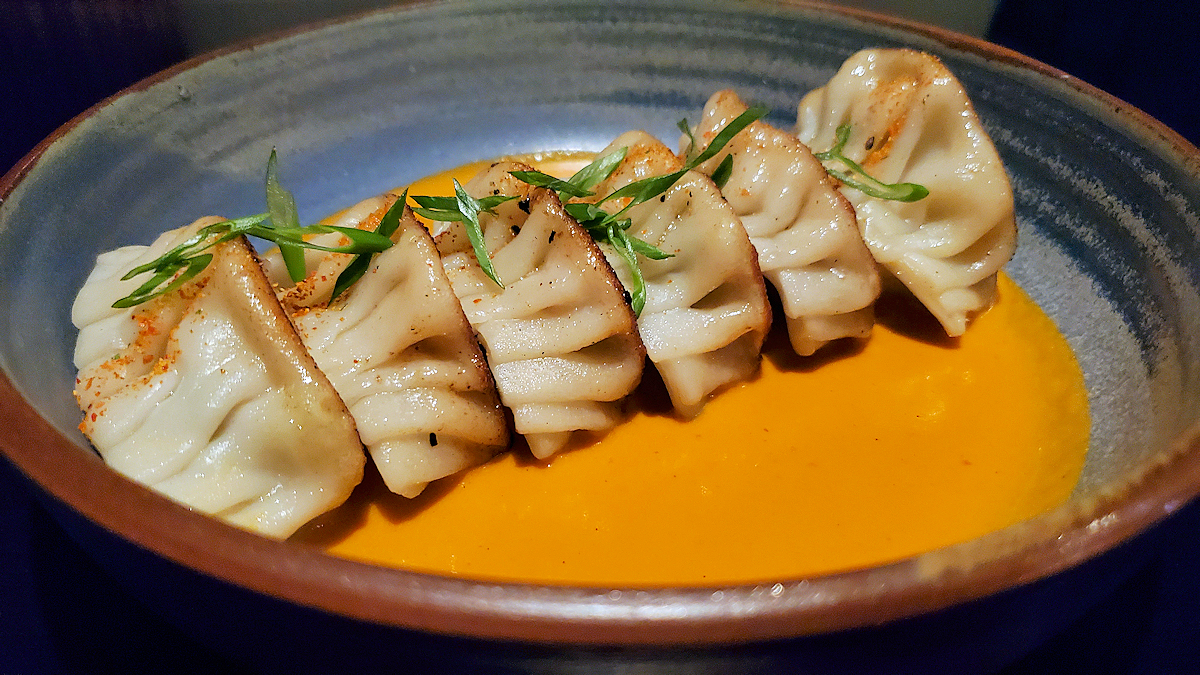
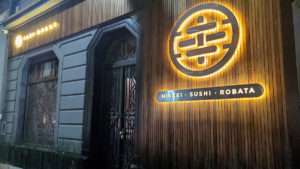
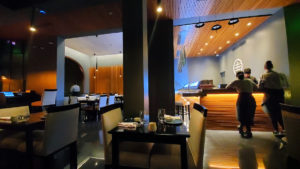
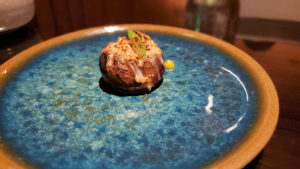
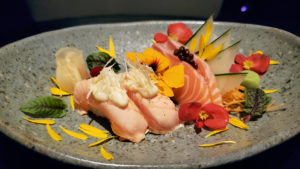
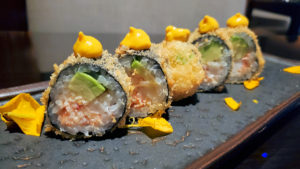
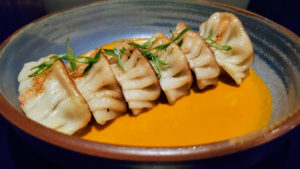
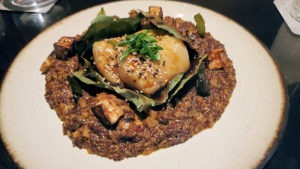
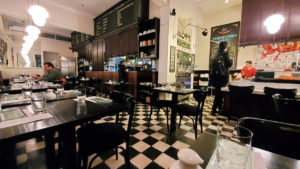
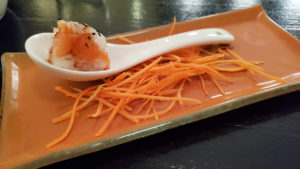
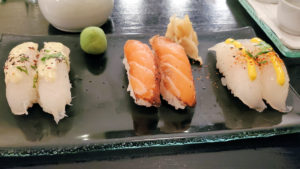
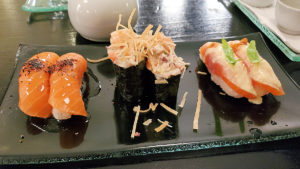
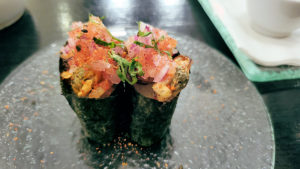
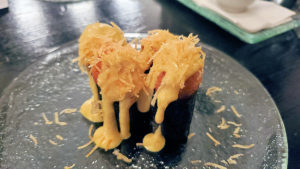
Now that you’ve been back to Taki Ongoy for your anniversary, is it any better. For a heads up, make your res on line through The Fork, 50% off, not including beverages.
A revisit to Taki Ongoy for our 15th anniversary date night out. First off, to Tom’s comment, it wasn’t bad the previous visit (other than one dish), it was mostly just really expensive, and we knew that going in. But we wanted to go out for a really nice “nikkei” evening, and we’ve been to La Mar and Osaka many times, so, something different.
But let’s parse it all out. Service was, at the least, not flu-laden. It still had its missteps. Our waitress forgot our wine order, and then got a bit flustered when we had our appetizers on the table, but wouldn’t eat them until the wine arrived – and even then we took our time, we’d wanted to have a nice glass of wine before we even dug in, and weren’t about to be pushed to hurry up just because they wanted to jump ahead to main courses. Even after we’d flagged her down for the wine after the apps were on the table, it still took them almost ten more minutes to get it to the table. And for some reason, the place seems to want to keep their shiny floor spotless, so every time someone walked through the room, a young woman with a damp cloth on a squeegee would run out from the back and shine over their footprints. Very annoying to have someone constantly mopping in the dining room when you’re eating, and far less classy than just having some shoe smudges on the shiny floor.
The menu is now on a tablet (I don’t think it was the last time, though maybe I just don’t recall that), and is organized in a way that each section off the main menu only has 3-4 dishes in it, so you have to constantly return to the main menu and select another section. Poor organization, and a real pain when you are trying to figure out what you want to eat.
The food was all very good. But still quite expensive. I’d say it hovers somewhere between the prices at the two other Nikkei spots mentioned above, but not as good as either, which means this was probably the last visit. The above four dishes, plus a shared dessert, and a bottle of wine, a couple of waters, and tip, and we’re talking 5500 pesos ($89) – pretty much the same, in 2020 peso terms as my solo visit last year. Unfortunately, I’d forgotten about that discount card they gave me – should have come back and read my original review beforehand. (And in reply to Tom’s comment, The Fork 50% offer is for their festival celebration, which hadn’t started yet when we went, or, wasn’t being offered at this place that night.)
Minor things about two of the dishes that I can nitpick on – the ceviche that’s completely uncured until you mash the fish down into the leche de tigre yourself, and which was heavy on lemon rather than lime; and the creme brulee, which flavor-wise was excellent, with it’s chocolate chili hit, had clearly been bruleed and then refrigerated, so that the caramelized sugar topping was no longer crunchy, it was melting into the custard below. Favorite dish was the stuffed chipirones, baby squid with prawns and charred corn.
The place has become very touristy, and from surrounding tables, I don’t think I heard anything in Spanish – it was all English, German, and Portuguese. The elderly British couple at the table next to us, clearly “in their cups”, spent our first twenty minutes there loudly talking about the various places they’ve eaten on their trip, at a volume that could have been heard outside, and then spent about five minutes walking around the dining room with their phones out, going up to other people’s tables, saying, “ooh, that’s pretty, let me just take a picture”…. Bizarrely, no one seemed to mind.
So, in the end, no, I just don’t think I recommend this place. Too many missteps, and too expensive for the quality of what you get.